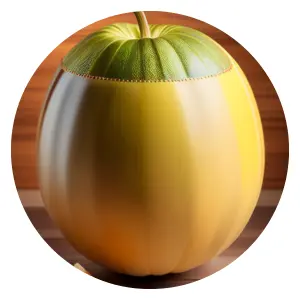Tips for Saving and Storing Melon Seeds
As the gardening season comes to a close, it’s time to start thinking about next year’s crop.
One way to ensure a successful and cost-effective harvest is by saving your melon seeds for planting in the following season.
Not only does this save you money on purchasing new seeds, but it also allows you to select and preserve the best plants from your current crop.
Saving and storing melon seeds may seem like a daunting task, but with a few tips and tricks, it can be an easy process that anyone can do at home.
In this article, we’ll provide you with all the information you need to collect, dry, store, and label your melon seeds so that they are ready for planting when next spring arrives.

Melon Seeds Menu
When to Harvest Melon Seeds
Melons are one of the most loved fruits in the world.
Whether you’re a farmer or just have a garden at home, knowing when to harvest melon seeds is important if you want to save and store them for next season.
If harvested too early, melon seeds may not be fully developed and may not germinate efficiently; on the other hand, if left too long, they may start to rot.
When harvesting melon seeds, it’s best to wait until the fruit is fully ripe before cutting it open.
To determine ripeness, look for signs such as a change in color from green to yellow or brown and a crackling sound when tapped.
Once you’ve cut open the fruit, scoop out the flesh along with any attached seeds using a spoon or your hands.
After collecting all the seeds from your ripe melons, wash them thoroughly in warm water to remove any remaining flesh or debris.
Then spread them out evenly on a paper towel and leave them in a cool, dry place for several days until completely dry.
Store your dried melon seeds in an air-tight container and keep them in a cool dark place until planting time next season.
Ideal time to harvest melon seeds for the best germination rates
The ideal time to harvest melon seeds is when the fruit is fully ripe.
This ensures that the seeds have reached full maturity, making them more viable for germination.
When harvesting, cut the melon open and scoop out the seeds.
Rinse them in a sieve under running water to remove any flesh or pulp. Then, spread them out on a paper towel or screen to dry completely before storing.
It’s important to note that different varieties of melons may have slightly different optimal harvest times for their seeds.
For example, muskmelons should be left on the vine until they begin to slip off easily, while watermelons are ready when their skin turns yellow and dull.
Storing your harvested melon seeds properly will also impact their germination rates next season.
Place them in an airtight container and store in a cool, dry place away from direct sunlight until planting time comes around again.
By following these simple steps, you can ensure that your melon seed collection stays healthy and productive year after year!
Selecting healthy, fully ripe fruits for seed collection
When it comes to seed collection, selecting healthy and fully ripe fruits is of utmost importance.
This is especially true for melon seeds as they require specific conditions to ensure proper germination.
Healthy fruits will yield better quality seeds that are more likely to sprout and grow into strong, productive plants.
Fully ripe fruits also play a crucial role in seed collection since immature or underripe fruits may not develop viable seeds.
Harvesting only the best fruit ensures that the seeds collected are of optimal quality and quantity.
Additionally, selecting healthy, fully ripe fruits can help prevent disease transmission from infected or damaged fruit to the new crop.
Overall, taking the time to carefully choose fruits for seed collection will greatly benefit future crops by ensuring strong and healthy plants with high yields.
By prioritizing quality over quantity during seed collection, gardeners can lay a solid foundation for successful gardening seasons ahead.
How to identify when melons are ready for seed collection
When it comes to collecting melon seeds, the most important step is to identify when the fruit is ripe enough to yield viable seeds.
One way to check for ripeness is by examining the skin of the melon.
Once the skin turns yellow or beige and starts cracking, it’s a sign that the fruit is mature and ready for seed collection.
Additionally, if you tap on the melon with your finger and hear a hollow sound, it’s another indication that it’s ripe.
Another way to determine if a melon is ready for seed collection is by checking its texture. The flesh should be soft but not mushy when pressed gently with your finger.
Furthermore, you can also check for sweetness by tasting a small piece of the fruit near where you plan on cutting open for seed removal; if it tastes sweet, then it’s likely that they’re ready for harvesting.
Once you’ve identified that your melons are indeed ripe enough for seed collection, cut them open carefully and scoop out the seeds into a clean bowl or container.
Remove any flesh or debris from around them before rinsing them in cool water and laying them out on a tray lined with paper towels to dry completely before storing them in an air-tight container until next planting season.
How to Harvest and Clean Melon Seeds
Harvesting and cleaning melon seeds is a simple process that can be done in just a few easy steps.
Once the fruit has fully ripened, cut it open and scoop out the seeds using a spoon or your hands.
Make sure to remove all of the flesh from the seeds by rinsing them thoroughly under running water.
Next, spread the seeds out on a clean towel or paper towel to dry completely. This may take several days depending on how moist they are, but it’s important to ensure that they are completely dry before storing them.
Once dry, transfer the seeds to an envelope or small container and label them with the type of melon and date harvested.
To store melon seeds for next season, keep them in a cool, dry place away from direct sunlight.
A refrigerator or freezer is ideal as it will help preserve their viability over time.
When you’re ready to plant again, simply remove them from storage and sow according to directions for that particular variety of melon.
With these tips, you’ll be able to enjoy fresh homegrown melons year after year!
Melon seed dreams - delightful projections! Planting for a fine next season selection. Store through winter with good preparation, Conditioning moisture from condensation. Containers must seal out all infection, Squeeze out air and close the rejection, Right climate, warmth and proper direction, Come spring your melon patch perfection!
Chappy The Gardener
Properly extract the seeds from the melons
When it comes to saving and storing melon seeds for next season, it’s important to properly extract the seeds from the melons.
To do this, start by slicing the melon in half and scooping out all of the flesh with a spoon or knife.
Next, place the seeds in a colander or strainer and rinse them thoroughly under running water.
Once you’ve rinsed off any remaining bits of fruit or pulp, spread the seeds out on a paper towel or clean cloth and allow them to dry completely.
It’s important not to rush this process, as any moisture left on the seeds can cause mold or rot during storage.
Finally, transfer your dried melon seeds into an airtight container such as a mason jar or resealable plastic bag.
Store your container in a cool, dry place away from direct sunlight until you’re ready to plant them next season.
With these simple steps, you’ll be able to save and store your own delicious melon seeds year after year!
Step-by-step instructions for cleaning the seeds and removing any remaining fruit flesh
Cleaning and storing melon seeds for next season is a great way to ensure that you have fresh seeds ready to plant.
However, before storing the seeds, it’s essential to remove any remaining fruit flesh.
Here are some step-by-step instructions on how to do so.
Firstly, cut the melon open and scoop out the seeds into a bowl.
Remove as much flesh as possible by gently rubbing the seeds with your fingers or using a colander to rinse them with water. Then fill another bowl with warm water and add two teaspoons of salt for every cup of water.
Next, place the cleaned seeds in this solution and let them soak for about 24 hours.
The saltwater helps break down any remaining fruit flesh and also prevents mold from forming on the seeds during storage.
After soaking, drain the water and spread out the seeds onto a paper towel or piece of cloth to air dry completely before storing them in an airtight container like a glass jar or plastic bag.
Ensure that they are stored in a cool, dry place away from sunlight until planting season arrives once again!
Tips for drying the seeds
After harvesting melon seeds, it is crucial to ensure that they are fully mature before storage.
The drying process is essential as it reduces the moisture content in the seeds and prevents them from rotting during storage.
To dry your melon seeds, start by spreading them out on a clean, flat surface that allows air circulation.
Avoid placing them in direct sunlight as it can cause the seeds to become too dry and brittle.
Once you have spread out your seeds, leave them to dry for at least a week or until they are fully hard and brittle when pressed between your fingers.
During this period, avoid touching or moving the seeds around excessively to prevent damage or mold growth.
Additionally, make sure that the area where you’re drying your melon seeds has low humidity levels and good ventilation.
Lastly, once your melon seeds are completely dry, store them in an airtight container such as a glass jar or plastic baggie.
Place your container in a cool, dark place like a pantry or cellar to maintain optimal conditions for seed storage.
Following these tips will help ensure that your melon seeds are adequately dried and preserved for planting next season!
Tips for Storing Melon Seeds
1. After removing the seeds from your melons, it’s important to clean them thoroughly.
Rinse the seeds in cool water and remove any leftover fruit tissue or debris. Then, lay the seeds out on a paper towel and let them air dry for a few days.
2. Once your melon seeds are completely dry, store them in an airtight container such as a glass jar or plastic bag.
Make sure to label the container with the type of melon and date you collected the seeds.
3. For long-term storage, place your sealed container of melon seeds in a cool, dark location such as a basement or pantry.
Seeds can be viable for several years if stored properly.
4. If you’re interested in sharing your saved melon seeds with friends or family members, consider creating seed packets with planting instructions included. This is also a great way to keep track of which varieties you’ve saved for future gardening seasons!
The best storage methods for preserving melon seeds
Melon seeds are a great source of nutrition and can also be used for planting in the next season.
However, it is essential to store them properly to ensure their viability.
One of the best storage methods for melon seeds is to dry them thoroughly before storing them in an airtight container. Spread the seeds out on a flat surface and leave them to air dry for about 2-3 weeks until they are completely dry.
Another effective way to preserve melon seeds is by freezing them.
After drying the seeds, pack them into an airtight container or plastic bag and freeze immediately.
When you’re ready to use these frozen seeds, allow them to thaw at room temperature before planting.
Storing your melon seeds in a cool, dark, and dry place will also help maintain their quality over time.
Avoid exposing your stored melon seeds to heat or moisture as this can reduce their viability significantly.
By following these simple steps, you can ensure that your saved melon seed collection remains healthy and viable for many growing seasons ahead!
Keeping seeds dry and cool
When it comes to saving and storing melon seeds for the next season, keeping them dry and cool is of utmost importance.
Seeds that are exposed to moisture can easily develop mold and decay, which will render them useless for planting.
Therefore, it’s essential to ensure that they are completely dried before storage.
One way to dry out your melon seeds is by placing them on a flat surface in a cool, well-ventilated room. This allows air to circulate around the seeds and helps evaporate any residual moisture quickly.
Alternatively, you can use a dehydrator or oven set at low temperatures to speed up the drying process.
Once your melon seeds are fully dried, store them in an airtight container such as a glass jar or plastic bag with all excess air squeezed out.
Keep these containers in a cool place away from direct sunlight or heat sources like radiators or ovens.
By taking these steps during seed storage, you’ll be able to save viable melon seeds for future seasons while avoiding mold growth and decay that could damage your entire stock of precious seeds!
Keep seeds organized and easy to find
1. Containers for Seed Storage: When it comes to storing melon seeds, it’s essential to choose the right container.
The ideal container should be airtight, moisture-resistant, and able to keep insects at bay.
Some of the best options include glass jars with tight-fitting lids, plastic containers with snap-on lids, or resealable plastic bags.
2. Labeling System: Once you’ve chosen your storage containers, it’s crucial to label them correctly.
A labeling system will help you identify the type of seed stored and when they were collected easily.
You can use stickers or labels that clearly indicate the date and variety of melon seeds contained in each container.
3. Organizing Your Seeds: It is also helpful to organize your seeds by type or variety in labeled containers for easy reference next season.
For example, if you have multiple types of melons growing in your garden – watermelon, honeydew melon – separate each type into its own designated container while labeling accordingly.
By following these simple steps for seed storage and organization, you can ensure the successful growth of your melons next season without any confusion about what you’re planting!
Tips for Testing Seed Viability
1.The Water Test: One of the most effective ways to test seed viability is through the water test.
Begin by filling a glass or jar with warm water and placing your seeds in it. If they sink to the bottom, then they are viable and able to germinate.
However, if the seeds float on top, then that means their internal structures have deteriorated, and you will not be able to grow them.
The Germination Test: Another way to check for seed viability is through germination testing.
To do this, place your seeds on a moist paper towel within a sealed container.
Leave them in a warm spot for several days and monitor their progress closely for signs of growth.
Seed Storage: Proper storage is essential when it comes to preserving your melon seeds’ viability for next season’s planting.
Be sure to store your seeds in an air-tight container in a cool, dry location away from sunlight or extreme temperatures that can compromise their integrity over time.
These simple tips will help ensure that you save viable Melon Seeds for next season’s planting while also providing peace of mind knowing that you’re using high-quality genetic material with excellent potential for successful growth and harvest!
Test the germination rate of saved melon seeds
One of the essential steps in saving and storing melon seeds is to test their germination rate. This process helps you identify how viable your saved seeds are and determine the number of seeds that will likely sprout.
To test the germination rate, place ten seeds on a moist paper towel and then fold it over to cover them entirely.
Afterwards, put the paper towel inside a plastic bag or container with some air holes for circulation.
Next, keep the container in a warm place with temperatures between 70-80 degrees Fahrenheit and ensure that you keep it damp but not soaking wet throughout.
After about five to seven days, check your seeds’ progress by looking at how many have sprouted; this shows their germination rate percentage-wise. Suppose all ten seeds have grown; this implies they have a 100% germination rate.
If six sprouted out of ten seeds, then it means you have a 60% germination rate.
In conclusion, testing your saved melon seed’s germination rate is crucial as it gives insight into which ones will likely grow once planted in soil next season.
With these steps mentioned above, you can easily determine your seed’s health status without having to wait until planting season to find out if they will grow successfully or not.
Tips for interpreting the results of the seed viability test
After performing a seed viability test on your saved melon seeds, it is important to interpret the results accurately.
Firstly, identify the percentage of viable seeds in your sample. If the percentage is high (above 80%), then you can expect a good germination rate when planting.
However, if the percentage is low (below 50%), then it may be best to discard those seeds and obtain fresh ones.
Next, consider the overall health of the viable seeds.
Check for any signs of damage or disease that may affect their ability to germinate and grow into healthy plants.
It’s also important to note any differences in size or appearance between viable and non-viable seeds.
Lastly, keep in mind that seed viability tests are not always 100% accurate and should be used as a guide rather than a definitive answer.
If you have doubts about the quality of your saved melon seeds, it may be wise to purchase new ones from a reputable source instead of taking chances with poor-quality or damaged seeds.
Adjust seed-saving practices
After conducting a germination test on your saved melon seeds, you can adjust your seed-saving practices accordingly.
If the germination rate is low, it may be due to poor storage conditions or improper seed saving techniques.
To improve on this, ensure that the melons are fully ripe before harvesting and clean off any pulp before drying the seeds.
Store them in an airtight container with silica gel packets to absorb moisture and prevent mold growth.
If the germination rate is high, congratulations! This means that your seed-saving methods were effective. You can continue using these same methods for next season’s seeds.
However, keep in mind that over time, even well-stored seeds will lose their viability.
Therefore, it’s always best to conduct regular germination tests to ensure that you’re planting viable seeds.
Lastly, if you’re looking to improve your success rate in seed saving and storing melon seeds for next season, consider purchasing heirloom varieties bred specifically for saving seeds.
These varieties have been selected over generations for their ability to produce reliable offspring from saved seeds and may be more forgiving of less-than-ideal storage conditions.
In conclusion, saving and storing melon seeds for the next season can be a fun and rewarding experience.
By following these tips, you’ll increase your chances of having a successful harvest next year.
Remember to choose healthy fruits, clean and dry the seeds properly, and store them in a cool and dry place.
Don’t forget to label your containers accordingly for easy identification in the future.
With some patience and effort, you can grow delicious melons year after year. Start preparing for next season now by saving those seeds!
Click To Grow
Helps Us Grow – Share If You Like



















